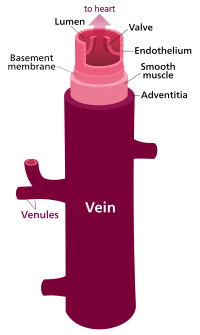
Photo from wikipedia
BACKGROUND As previous studies demonstrated conflicting results, we investigated the hemodynamic and renal outcomes of the intra-operative use of a veno-venous bypass during liver transplantation. METHODS The intraoperative levels of… Click to show full abstract
BACKGROUND As previous studies demonstrated conflicting results, we investigated the hemodynamic and renal outcomes of the intra-operative use of a veno-venous bypass during liver transplantation. METHODS The intraoperative levels of mean artery pressure, cardiac index, inferior vena cava and renal perfusion pressures were compared in liver transplant patients receiving or not the bypass. RESULTS We enrolled 38 patients: 20 with the bypass and 18 without. No differences characterized the two groups regarding gender (p=0.95), age (p=0.32), BMI (p=0.09), liver disease indicating LT and preoperative serum creatinine levels. Patients with the bypass received more intraoperative fluids (crystalloids and colloids) but with no difference in terms of intraoperative blood products and vasopressors requirements (p= 0.33). After clamping of the inferior vena cava, patients with the bypass showed higher mean artery pressure. Simultaneously, pressure in the inferior vena cava below the clamp level sharply increased Vs baseline (p<0.0001) independently of the use of the bypass and remained high until clamp release. Consequently, renal perfusion pressure dropped abruptly (p <0.0001) after vena cava clamping and returned to baseline only upon clamp removal. Overall, 18 subjects developed post-operative acute kidney injury which was equally distributed between patients with (n=9) or without (n =8) the bypass. CONCLUSIONS Our data suggest that the use of a veno-venous bypass fails to release the increased renal venous backflow from inferior vena cava clamping resulting in renal congestion with reduced renal perfusion pressure.
Journal Title: Minerva anestesiologica
Year Published: 2022
Link to full text (if available)
Share on Social Media: Sign Up to like & get
recommendations!